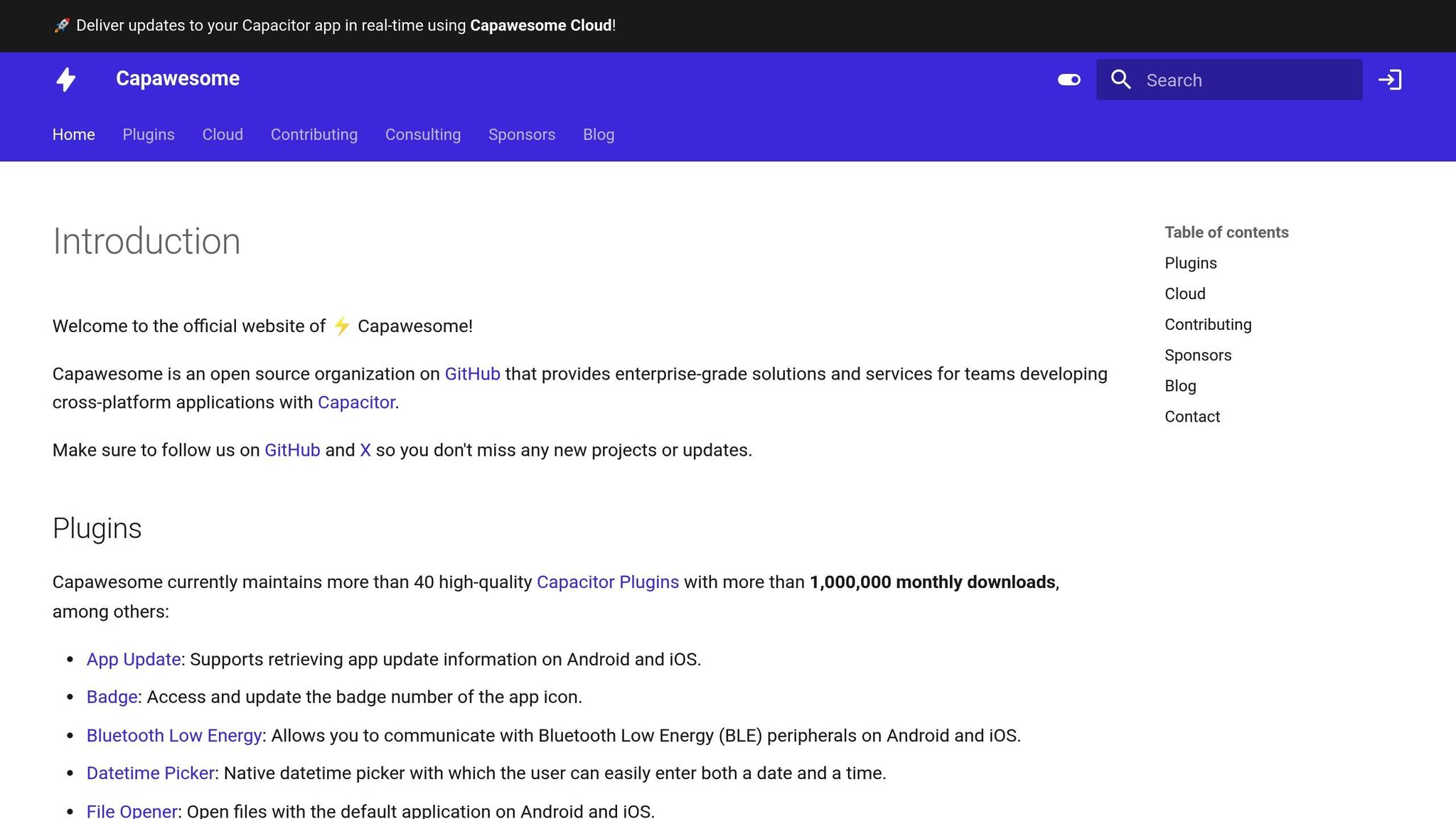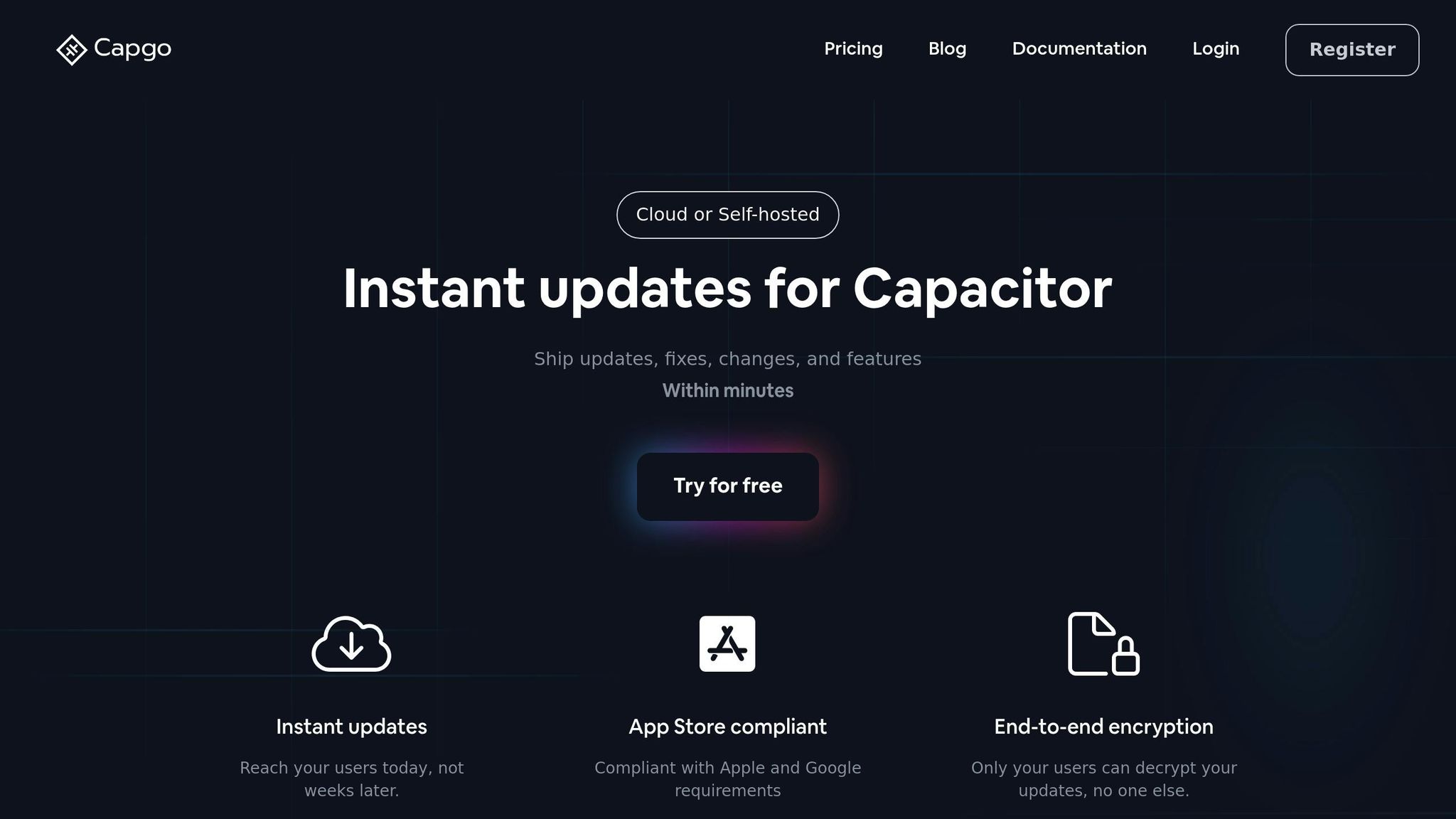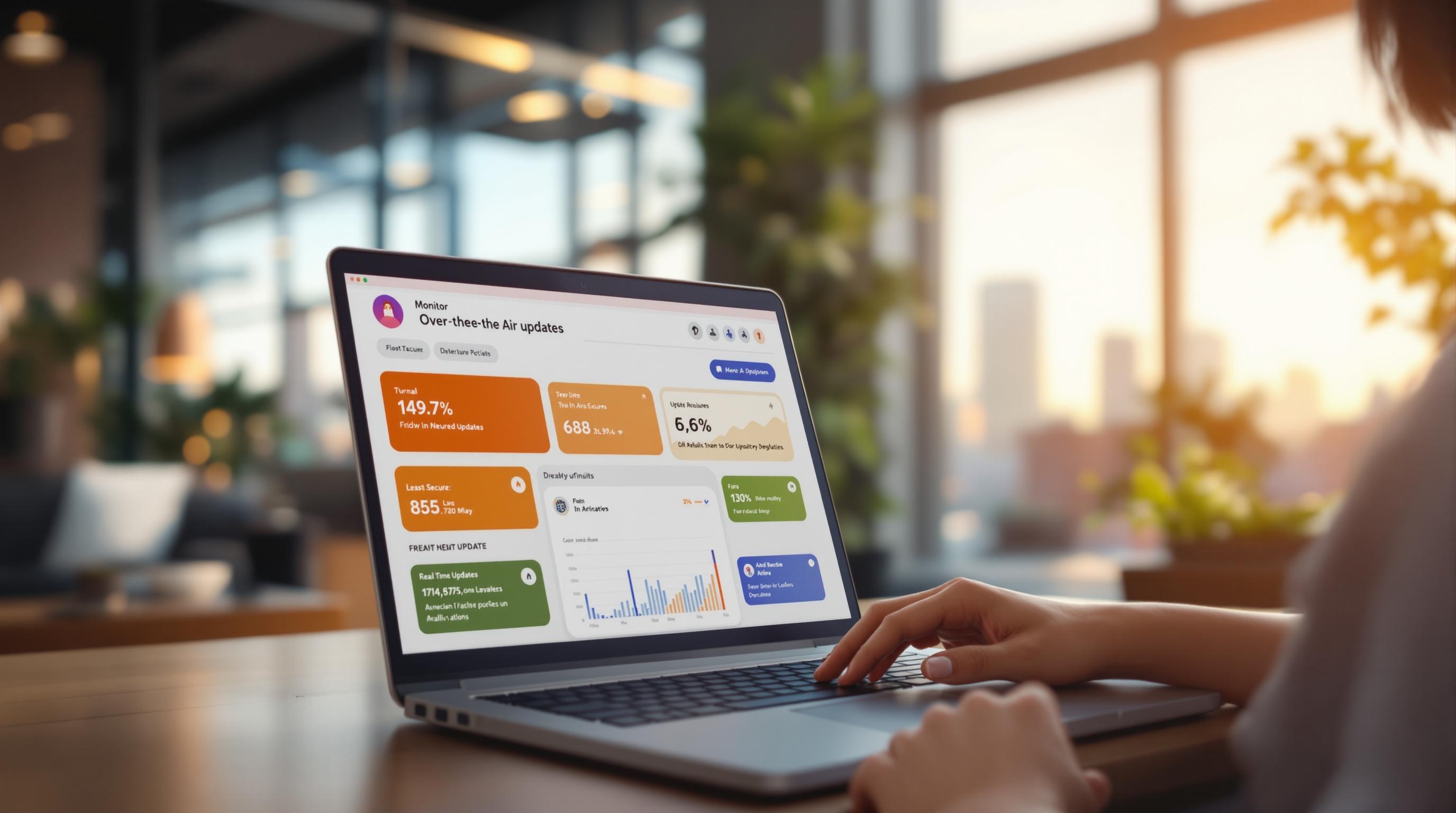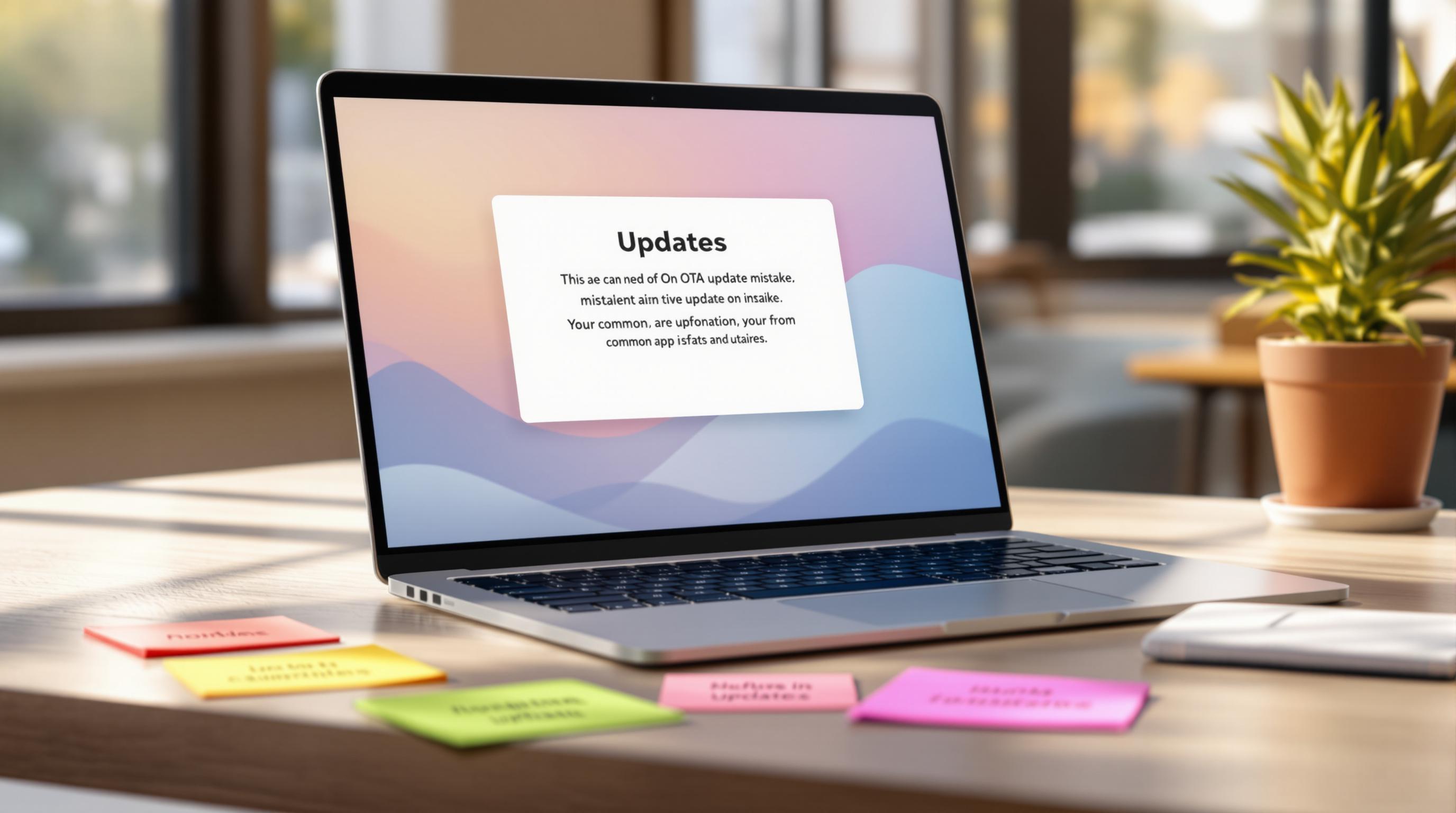Want to update your app without waiting for app store approvals? OTA (Over-The-Air) updates let you push fixes and features directly to users in real-time. With tools like Capgo, you can monitor update performance, track errors, and even roll back bad updates instantly.
Key Benefits of Monitoring OTA Updates:
- Fast Updates: Reach up to 95% of active users within 24 hours.
- Error Tracking: Spot and fix deployment issues early.
- Secure Delivery: End-to-end encryption ensures updates are safe.
- Real-Time Analytics: Monitor success rates (global average: 82%) and performance metrics.
Quick Setup Steps:
- Install the Capgo plugin:
npx @capgo/cli init. - Use version control with channels (Production, Beta, Staging).
- Enable real-time analytics and error tracking.
- Set up auto-rollback for failed updates.
Capgo has already managed 23.5M updates across 750 apps with fast download speeds (114ms for a 5MB bundle). Start monitoring your updates today for smoother app management.
Explore Capawesome’s New Ionic Capacitor Live Update …

Setting Up Update Monitoring
Here’s how to set up OTA update monitoring for your app:
Installing the Required Plugin
First, install the Capgo plugin by running:
npx @capgo/cli initThis plugin works seamlessly with Capacitor 6 and 7, making it compatible with a range of app versions.
Managing Update Versions
Version control plays a key role in handling OTA updates. Capgo’s channel system helps you manage update distribution efficiently:
| Channel Type | Purpose | Best Use Case |
|---|---|---|
| Production | Main release channel | Stable updates for all users |
| Beta | Testing channel | Early access features |
| Staging | Pre-release testing | Internal QA testing |
Each channel keeps its own version history, allowing developers to track changes and manage updates systematically. Plus, the system offers instant rollback options, so you can quickly address any deployment issues.
Once version control is set up, you can monitor updates to ensure security and performance.
Setting Up Capgo Monitoring

- Configure Analytics Integration: Use real-time analytics to monitor update performance and user engagement.
- Enable Error Tracking: Activate error tracking to capture detailed logs and performance metrics.
- Set Up Distribution Rules: Define rollout parameters to control update speed and target specific user groups.
These steps create a reliable monitoring system for your app.
“Capgo is a must have tools for developers, who want to be more productive. Avoiding review for bugfix is golden.” - Bessie Cooper [1]
Capgo ensures secure update delivery with end-to-end encryption, while built-in analytics, rollback options, and real-time monitoring help maintain app stability.
Error Handling and Tracking
App-Level Monitoring
Effective app-level monitoring is key to ensuring smooth OTA update performance. Capgo’s system provides detailed insights into update delivery and installation, achieving an 82% global success rate [1].
Here’s how you can set up app-level monitoring:
import { CapacitorUpdater } from '@capgo/capacitor-updater'
// Listen for update eventsCapacitorUpdater.addListener('updateAvailable', (info) => { console.log('New update available:', info.version)})
// Track installation progressCapacitorUpdater.addListener('downloadComplete', (info) => { console.log('Update downloaded:', info.version)})For a complete picture, combine this with backend error tracking to address issues from both ends.
Backend Error Tracking
Backend monitoring complements app-level insights by focusing on overall system performance. With Capgo managing 23.5M updates worldwide [1], tracking backend errors is essential for maintaining reliability.
| Tracking Metric | Purpose | Impact |
|---|---|---|
| Update Success Rate | Tracks successful installations | Keeps 95% of users updated within 24 hours [1] |
| Download Performance | Monitors bandwidth usage | Improves delivery speed |
| Error Frequency | Identifies recurring issues | Reduces failure rates |
By keeping tabs on these metrics, you can quickly identify and resolve problems, ensuring a smooth update process.
Auto-Rollback Setup
When deployment errors occur, automatic rollback prevents user disruption. Capgo’s rollback feature activates instantly, minimizing downtime during deployment [1].
Here’s an example of how to configure auto-rollback:
try { await CapacitorUpdater.download({ version: 'latest' })} catch (error) { // Automatically trigger rollback await CapacitorUpdater.rollback()}This approach has proven reliable, with 750 apps currently using Capgo’s system in production [1]. Its broad adoption highlights the dependability of these error-handling tools.
Monitoring Guidelines
These guidelines leverage Capgo’s monitoring tools to make every update measurable, secure, and carefully deployed.
Update Performance Tracking
Keep a close eye on OTA update performance by monitoring key metrics like success rate, user engagement, download speed, and error frequency. Here’s a code snippet to help track these metrics:
import { CapacitorUpdater } from '@capgo/capacitor-updater'
// Set up performance trackingCapacitorUpdater.addListener('updateStats', (stats) => { console.log('Download speed:', stats.downloadSpeed) console.log('Success rate:', stats.successRate)})Use these insights to guide your staged deployment plans effectively.
Phased Update Rollouts
Phased rollouts help minimize risks by gradually releasing updates to specific user groups. Capgo’s Channel System makes it easy to manage controlled deployments. Start with internal testers, move to beta users, and then expand to the general audience. Monitor each phase for at least 24 hours before proceeding. This method has contributed to Capgo achieving an 82% success rate globally [1].
Security and Store Compliance
To complement phased rollouts, secure update delivery is critical. Enable secure update verification using the following code:
// Enable secure update verificationawait CapacitorUpdater.download({ version: 'latest', validateSignature: true, checksum: true})“The only solution with true end-to-end encryption, others just sign updates” - Capgo [1]
This ensures updates comply with security standards and keeps user data safe through regular audits and validation processes.
Summary
This section recaps the main steps for monitoring OTA updates and highlights the features that make Capgo a standout choice for update management.
Key Monitoring Steps
Effective OTA update monitoring involves several critical components. These steps, discussed earlier, ensure updates are deployed efficiently and issues are addressed quickly:
| Monitoring Component | Purpose | Impact |
|---|---|---|
| Real-time Analytics | Measure update success and user engagement | Identifies problems immediately |
| Error Tracking | Detect and resolve issues early | Minimizes disruptions for users |
| Version Control | Manage how updates are distributed | Keeps rollouts controlled and predictable |
| Performance Metrics | Track download speeds and success rates | Preserves a smooth user experience |
Capgo Features Overview
Since its launch in 2022, Capgo has become a go-to tool for OTA update monitoring, offering solutions that help teams move away from outdated update methods.
“We practice agile development and @Capgo is mission-critical in delivering continuously to our users!” – Rodrigo Mantica [1]
Capgo’s tools are built to handle OTA updates with precision. Here’s what sets it apart:
- Real-time Analytics: Tracks update success rates to quickly address issues
- End-to-end Encryption: Protects updates with strong security protocols
- Channel System: Allows targeted monitoring for specific user groups
- One-click Rollback: Quickly revert to an earlier version if problems arise
These features have gained traction among developers, reflected in growing adoption rates and positive feedback from users.




